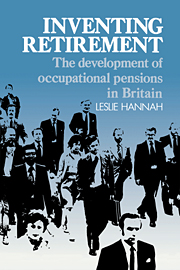Book contents
- Frontmatter
- Contents
- List of tables and figures
- Preface
- Part I The rise of pensioning
- Part II The shaping of the modern pensions institution
- 6 Accident and design in the evolution of pensions
- 7 Pensions in peril? Security, solvency and vesting
- 8 Designing the benefit structure
- 9 Retirement: age discrimination or the fruits of prosperity?
- Epilogue: Contemporary critics and the future of pensions
- Statistical appendix
- A note on sources
- Notes
- Index
8 - Designing the benefit structure
Published online by Cambridge University Press: 03 May 2010
- Frontmatter
- Contents
- List of tables and figures
- Preface
- Part I The rise of pensioning
- Part II The shaping of the modern pensions institution
- 6 Accident and design in the evolution of pensions
- 7 Pensions in peril? Security, solvency and vesting
- 8 Designing the benefit structure
- 9 Retirement: age discrimination or the fruits of prosperity?
- Epilogue: Contemporary critics and the future of pensions
- Statistical appendix
- A note on sources
- Notes
- Index
Summary
the only pension fund really worth considering is a final salary scheme, and I would like to go further than that and say that the scheme whereby pensions automatically increase after retirement according to the cost of living, if you can afford it, is an ideal scheme …
G. Ross Goobey (Imperial Tobacco Pension Funds) in Association of Superannuation and Pension Funds, Autumn Conference 1960, p. 41Pension schemes, when they were inaugurated, usually promised a level of retirement benefits in an apparently firm formula, which was felt, at the time, to suit the needs of employer and members alike. When retirement came – forty years later for young members of newly inaugurated schemes – it was rare for the original benefit structure to have been retained. The twentieth-century experience so far thus suggests that pension promises are not firm, but are subject to quite frequent alteration. As we saw in the previous chapter, alterations are subject to certain legal safeguards, but are principally determined by the needs of the employment contract and the financial well-being of the fund. These factors might be expected to produce a rich variety in pension benefit formulae, and in the past they have done so. More recently, however, there has been a remarkable convergence of pension schemes on what appears to be a standard design.
- Type
- Chapter
- Information
- Inventing RetirementThe Development of Occupational Pensions in Britain, pp. 105 - 121Publisher: Cambridge University PressPrint publication year: 1986



